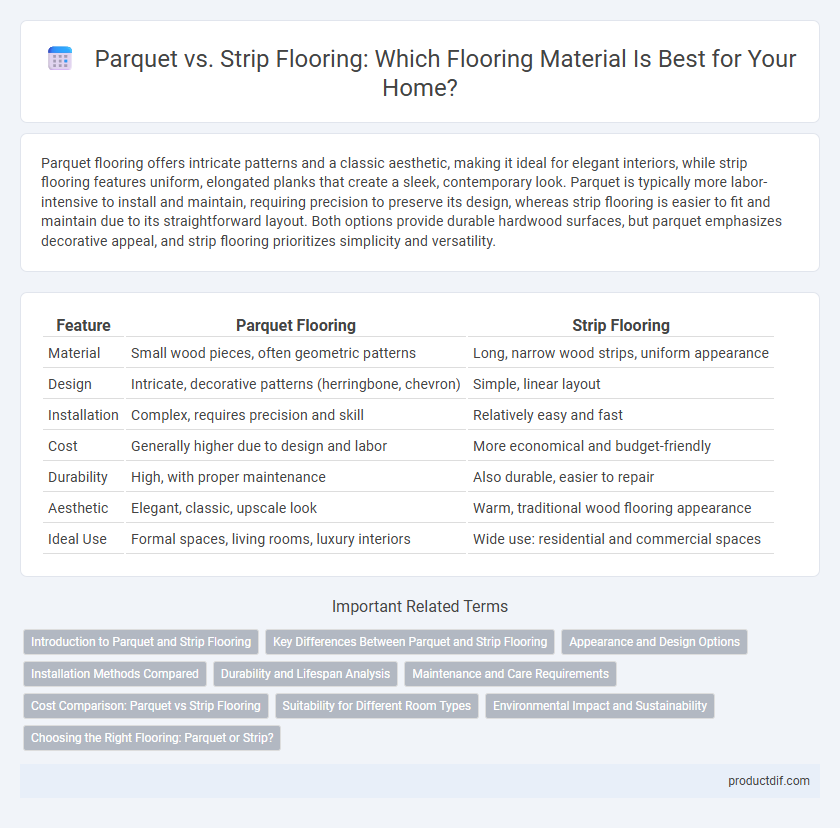Parquet flooring offers intricate patterns and a classic aesthetic, making it ideal for elegant interiors, while strip flooring features uniform, elongated planks that create a sleek, contemporary look. Parquet is typically more labor-intensive to install and maintain, requiring precision to preserve its design, whereas strip flooring is easier to fit and maintain due to its straightforward layout. Both options provide durable hardwood surfaces, but parquet emphasizes decorative appeal, and strip flooring prioritizes simplicity and versatility.
Table of Comparison
| Feature | Parquet Flooring | Strip Flooring |
|---|---|---|
| Material | Small wood pieces, often geometric patterns | Long, narrow wood strips, uniform appearance |
| Design | Intricate, decorative patterns (herringbone, chevron) | Simple, linear layout |
| Installation | Complex, requires precision and skill | Relatively easy and fast |
| Cost | Generally higher due to design and labor | More economical and budget-friendly |
| Durability | High, with proper maintenance | Also durable, easier to repair |
| Aesthetic | Elegant, classic, upscale look | Warm, traditional wood flooring appearance |
| Ideal Use | Formal spaces, living rooms, luxury interiors | Wide use: residential and commercial spaces |
Introduction to Parquet and Strip Flooring
Parquet flooring features small wooden pieces arranged in geometric patterns, offering a decorative and durable surface ideal for enhancing interior aesthetics. Strip flooring consists of narrow, long wooden planks that create a uniform and traditional wood floor appearance, providing both strength and ease of installation. Both options utilize hardwood species like oak, maple, or walnut, catering to different design preferences and functional requirements in residential and commercial spaces.
Key Differences Between Parquet and Strip Flooring
Parquet flooring features geometric patterns created from small wood pieces, offering a decorative and intricate design, while strip flooring consists of long, narrow wood boards laid side by side for a simpler, linear appearance. Parquet is commonly used in formal spaces due to its artistic aesthetic, whereas strip flooring suits casual or traditional interiors with its uniform and consistent look. Maintenance for parquet can be more complex because of its numerous joints, unlike strip flooring which tends to be easier to clean and repair.
Appearance and Design Options
Parquet flooring offers intricate geometric patterns such as herringbone and basketweave, enhancing visual interest and elegance in interior spaces. Strip flooring features long, narrow planks with a uniform appearance, creating a classic and seamless look that complements various design styles. Both options provide diverse wood species and finishes, but parquet stands out for its decorative artistry, while strip flooring emphasizes simplicity and continuity.
Installation Methods Compared
Parquet flooring requires precise installation methods such as gluing or nailing small wood pieces in intricate patterns, demanding skilled craftsmanship and more time. Strip flooring involves laying longer, uniform wood boards with tongue-and-groove joints, allowing faster installation and straightforward alignment. Both methods demand proper subfloor preparation, but parquet's complexity increases labor costs compared to the more conventional strip flooring approach.
Durability and Lifespan Analysis
Parquet flooring offers superior durability due to its multi-layer construction and intricate patterns that resist wear and tear better than strip flooring. Strip flooring, typically made from solid hardwood planks, is prone to scratches and dents but can be sanded and refinished multiple times, extending its lifespan up to 30 years or more. Parquet floors generally last longer, often exceeding 40 years with proper maintenance, making them a more resilient option for high-traffic areas.
Maintenance and Care Requirements
Parquet flooring requires regular dusting and occasional polishing to maintain its intricate patterns and prevent dullness, with prompt attention to spills to avoid water damage. Strip flooring, characterized by longer wooden boards, benefits from routine sweeping and mopping using a damp cloth and wood-safe cleaners to preserve its smooth finish and prevent warping. Both flooring types necessitate protective measures such as furniture pads and humidity control to extend their lifespan and maintain aesthetic appeal.
Cost Comparison: Parquet vs Strip Flooring
Parquet flooring generally costs more than strip flooring due to its intricate design and higher labor expenses, with average prices ranging from $8 to $15 per square foot compared to $3 to $8 per square foot for strip flooring. Material quality and wood species, such as oak or walnut, significantly influence the price in both flooring types. Installation complexity and finishing requirements also impact the overall cost, making parquet a premium option for stylish and durable flooring.
Suitability for Different Room Types
Parquet flooring suits formal spaces like living rooms and dining areas due to its intricate patterns that enhance elegance and visual interest. Strip flooring, with its simpler and more uniform appearance, is ideal for bedrooms and hallways, offering a classic and versatile look that complements various interior styles. Both options provide durability, but parquet excels in high-traffic areas where aesthetic impact is a priority.
Environmental Impact and Sustainability
Parquet flooring, made from smaller wood pieces often sourced from sustainably managed forests, typically offers better environmental sustainability compared to strip flooring, which usually requires larger tree sections and can contribute to more deforestation. The production process for parquet flooring generates less waste due to efficient wood use, and its durability extends the lifecycle, reducing the need for frequent replacement. Conversely, strip flooring's higher raw material demand and often shorter lifespan amplify its overall environmental footprint, making parquet the more eco-friendly choice for sustainable flooring solutions.
Choosing the Right Flooring: Parquet or Strip?
Parquet flooring offers intricate geometric patterns and a classic aesthetic ideal for enhancing formal spaces, while strip flooring provides a uniform, linear design that suits modern minimalist interiors. Selecting the right flooring depends on room size, style preference, and maintenance considerations, with parquet requiring more upkeep due to its complexity compared to the easier-to-maintain strip flooring. Both options use hardwood species like oak, maple, or cherry, affecting durability and finish, so evaluating specific wood types alongside pattern choices ensures optimal longevity and visual appeal.
Parquet vs Strip Flooring Infographic

 productdif.com
productdif.com